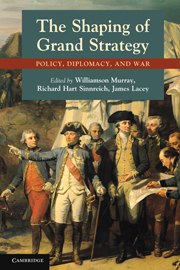Book contents
- Frontmatter
- Contents
- Contributors
- 1 Thoughts on grand strategy
- 2 The grand strategy of the grand siècle: Learning from the wars of Louis XIV
- 3 Strategic culture and the Seven Years' War
- 4 Strategy as character: Bismarck and the Prusso-German question, 1862–1878
- 5 About turn: British strategic transformation from Salisbury to Grey
- 6 British grand strategy, 1933–1942
- 7 Toward a strategy: Creating an American strategy for global war, 1940–1943
- 8 Harry S. Truman and the forming of American grand strategy in the Cold War, 1945–1953
- 9 Patterns of grand strategy
- Index
- References
8 - Harry S. Truman and the forming of American grand strategy in the Cold War, 1945–1953
Published online by Cambridge University Press: 05 June 2012
- Frontmatter
- Contents
- Contributors
- 1 Thoughts on grand strategy
- 2 The grand strategy of the grand siècle: Learning from the wars of Louis XIV
- 3 Strategic culture and the Seven Years' War
- 4 Strategy as character: Bismarck and the Prusso-German question, 1862–1878
- 5 About turn: British strategic transformation from Salisbury to Grey
- 6 British grand strategy, 1933–1942
- 7 Toward a strategy: Creating an American strategy for global war, 1940–1943
- 8 Harry S. Truman and the forming of American grand strategy in the Cold War, 1945–1953
- 9 Patterns of grand strategy
- Index
- References
Summary
In the absence of theory, the facts are silent.
– F. A. HayekWith more than a little help from his loyal lieutenants, and with some notable assistance from European statesmen and officials, President Harry S. Truman won the Cold War in the brief period from 1947 to 1949 – so, at least, the wisdom of hindsight attempts to persuade us today. It is the central purpose of this essay to examine the quality of Truman's leadership of American policy and grand strategy throughout this period. Because the story is both highly complex and eminently contestable, it is essential to be crystal clear about the “plot” for 1945–1953. Lest the complications and the myriad detail which follow these opening paragraphs inadvertently muddy the water of understanding unduly, let the author be quite explicit about the argument he will advance and test. This argument rests on four claims.
First, and most important, Harry Truman got the “big things” right enough. He did sufficiently well what political leaders are supposed to do: he made sufficiently correct judgment calls on the most important issues of the day. The American people do not elect their presidents to run the government in any detailed sense, though from time to time, they must strive to immerse themselves in the details pertinent to particular questions. Rather it is the job of presidents, above all else, to make the decisions that have the largest potential consequences and to police the execution of those decisions.
- Type
- Chapter
- Information
- The Shaping of Grand StrategyPolicy, Diplomacy, and War, pp. 210 - 253Publisher: Cambridge University PressPrint publication year: 2011
References
- 1
- Cited by



